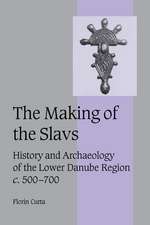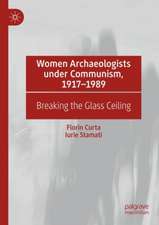The Velestino Hoard: Casting Light on the Byzantine 'Dark Ages': New Approaches to Byzantine History and Culture
Autor Florin Curta, Bartłomiej Szymon Szmoniewskien Limba Engleză Hardback – 8 mar 2019
Din seria New Approaches to Byzantine History and Culture
- 15%
 Preț: 635.96 lei
Preț: 635.96 lei - 15%
 Preț: 693.57 lei
Preț: 693.57 lei - 18%
 Preț: 791.57 lei
Preț: 791.57 lei - 15%
 Preț: 530.42 lei
Preț: 530.42 lei - 15%
 Preț: 705.34 lei
Preț: 705.34 lei - 15%
 Preț: 697.82 lei
Preț: 697.82 lei - 18%
 Preț: 891.96 lei
Preț: 891.96 lei - 9%
 Preț: 762.75 lei
Preț: 762.75 lei - 18%
 Preț: 722.89 lei
Preț: 722.89 lei - 18%
 Preț: 721.63 lei
Preț: 721.63 lei - 18%
 Preț: 724.63 lei
Preț: 724.63 lei - 18%
 Preț: 725.75 lei
Preț: 725.75 lei - 15%
 Preț: 634.49 lei
Preț: 634.49 lei - 18%
 Preț: 781.00 lei
Preț: 781.00 lei - 15%
 Preț: 691.91 lei
Preț: 691.91 lei - 18%
 Preț: 727.48 lei
Preț: 727.48 lei - 18%
 Preț: 732.70 lei
Preț: 732.70 lei - 15%
 Preț: 637.13 lei
Preț: 637.13 lei - 18%
 Preț: 735.84 lei
Preț: 735.84 lei - 18%
 Preț: 738.69 lei
Preț: 738.69 lei - 18%
 Preț: 953.65 lei
Preț: 953.65 lei - 18%
 Preț: 785.55 lei
Preț: 785.55 lei
Preț: 532.56 lei
Preț vechi: 626.55 lei
-15% Nou
Puncte Express: 799
Preț estimativ în valută:
101.91€ • 106.67$ • 84.82£
101.91€ • 106.67$ • 84.82£
Carte tipărită la comandă
Livrare economică 31 martie-14 aprilie
Preluare comenzi: 021 569.72.76
Specificații
ISBN-13: 9783030048457
ISBN-10: 3030048454
Pagini: 206
Ilustrații: XIII, 237 p. 58 illus., 47 illus. in color.
Dimensiuni: 148 x 210 mm
Greutate: 0.56 kg
Ediția:1st ed. 2019
Editura: Springer International Publishing
Colecția Palgrave Macmillan
Seria New Approaches to Byzantine History and Culture
Locul publicării:Cham, Switzerland
ISBN-10: 3030048454
Pagini: 206
Ilustrații: XIII, 237 p. 58 illus., 47 illus. in color.
Dimensiuni: 148 x 210 mm
Greutate: 0.56 kg
Ediția:1st ed. 2019
Editura: Springer International Publishing
Colecția Palgrave Macmillan
Seria New Approaches to Byzantine History and Culture
Locul publicării:Cham, Switzerland
Cuprins
1. Introduction.- 2. Forgery or Genuine?.- 3. Humans or Human-like Figures.- 4. Real and Fantastic Animals.- 5. Ornaments.- 6. Style and Chronology.- 7. Production.- 8. Function: Dies or Models?.- 9. Historical Context.- 10. Conclusion.- Catalogue.- Appendix A.- Appendix B.- References.
Notă biografică
Florin Curta is Professor of Medieval History and Archaeology at the University of Florida, USA. He is the author of Southeastern Europe in the Middle Ages, 500-1250 (2006) and The Edinburgh History of the Greeks, c. 500 to 1050: The Early Middle Ages (2011).
Bartłomiej Szymon Szmoniewski is an archaeologist at the Institute of Archaeology and Ethnology of the Polish Academy of Sciences. He is co-author of four monographs and published several papers dedicated to the various topics of early medieval archaeology and history.
Bartłomiej Szymon Szmoniewski is an archaeologist at the Institute of Archaeology and Ethnology of the Polish Academy of Sciences. He is co-author of four monographs and published several papers dedicated to the various topics of early medieval archaeology and history.
Textul de pe ultima copertă
This book examines the remarkable Velestino hoard, found in Thessaly in the 1920s, and analyses the light that this collection of artifacts sheds on a poorly studied period of Byzantine history, and on largely neglected aspects of Byzantine civilization. Many collections of Byzantine gold- and silverware, such as Vrap and Seuso, have been surrounded by controversy. None, however, has been under more suspicion than the Velestino hoard, particularly with regards to its authenticity. The hoard contains no gold and no silver, and is in fact a collection of bronze and leaden plaques, some with human, and others with animal or geometric representations. The authors examine three distinct aspects of the hoard: the iconography of its components, the method of its production, and the function of those components. The conclusions that they reached provide valuable new insights into eighth-century Byzantine culture. The book explores the Byzantine cultural and political context of the Velestino hoard and will appeal to historians and art historians of early Byzantium, as well as archaeologists and historians of early medieval technologies.
Caracteristici
Examines, in detail, the origins, iconography and purpose of the Velestino hoard Explores the Byzantine cultural and political context in which the Velestino hoard was created Provides fresh insights into a poorly studied period of Byzantine history




